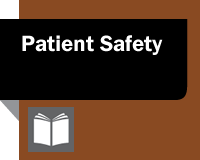2022 HME Business Handbook: Patient Safety
Keeping Patients Safe And Ensuring They Don't Take A Tumble
- By Robyn "Redd" Smith
- Jun 01, 2022
 Two separate parties
walk into an older movie
theater; a 25-year-old with friends,
and a 68-year-old on her own. Both
trip and fall due to torn spots in the
carpet while getting to their seats.
Neither are injured. Both enjoy their
movie, returning home after the show.
Two separate parties
walk into an older movie
theater; a 25-year-old with friends,
and a 68-year-old on her own. Both
trip and fall due to torn spots in the
carpet while getting to their seats.
Neither are injured. Both enjoy their
movie, returning home after the show.
That evening, each of them
reports their fall to their family.
The 25-year-old states, “I was
a total klutz today at the movie
and tripped over the carpet
and dropped my popcorn.” The
68-year-old tells family, “First off,
I’m okay. I had a fall today when
I was at the movies.” The younger
person’s family has a good laugh,
while the older individual’s family
immediately starts to discuss their
loved one’s future: “You can’t go
places alone anymore. Maybe you
need a cane or a rollator?”
Why the difference? The World
Health Organization reported
in 2021, “Older people have the
highest risk of death or serious
injury arising from a fall and
the risk increases with age. For
example, in the United States of
America, 20-30 percent of older
people who fall suffer moderate to
severe injuries such as bruises, hip
fractures, or head trauma.” To a
younger person, a fall is usually
just an embarrassing moment with
maybe a couple of bruises. To an
older individual, it may be a lifealtering
event.
ARE ALL FALLS THE SAME?
Falls can be classified into two different
categories: Mechanical and Organic.
Mechanical Falls are falls caused by an
interaction between an individual and
their environment. Examples: Tripping
over a throw rug, leaning against a
non-stable item, slipping on a wet or
cluttered surface. While these types of
falls can be experienced by all ages, the
higher injury rate of older individuals
makes their risk much more concerning.
However, these types of falls can be
decreased substantially by a speedy
change in, or interaction with, the
offending environment. 1) Tacking down
or getting rid of throw rugs. 2) Assuring
the stability of items such as tables,
chairs, sofas, etc. 3) Immediate clean-up
of any item on the floor such as liquids or
food spills that can cause a fall. Identify
the problem and solve.
The second type is Organic Falls.
These are caused by a person having a
body system failure that precipitates a
fall, such as standing up too quickly and
becoming lightheaded or losing balance
due to loss of sensation in a limb.
REDUCING THE RISK OF ORGANIC FALLS
While it is quite simple to remove a
trip hazard, affecting causal factors
in Organic Falls is somewhat more
complicated. Light-headedness upon
rising, known clinically as Orthostatic
Hypotension, can be experienced by
those who have been seated/standing
for an extended period, or can be due to
vascular damage; both might result in a
fall. When gravity leads to blood pooling
in the lower extremities, our bodies
utilize the “Calf Muscle Pump” to move
the blood up the body. Each time the
calf muscle (gastrocnemius) is actuated,
it contracts against veins in the area
and blood is moved up the body via the
opening/closing of valves in the veins.
Conversely, any activity that limits that
calf movement causes blood to remain in
the lower legs. The result of arising too
quickly can result in a fall due decrease in
blood availability to the brain. For those
individuals without vein disease, simply
moving their feet in a foot pump action
before arising can limit the number of
episodes of orthostatic hypotension.
But what about individuals with
chronic venous insufficiency (CVI) and
incompetent valves? Is there anything
that can be done to lower the risk of an
Organic Fall for these individuals?
COMPRESSION BENEFITS
A 2018 study has shown compression
can help. This study examined
individuals wearing medical compression
stockings (MCS) and the effects on
somatosensory function (ability to
interpret bodily sensation). A decrease
of this function has been associated
with an increased risk in Organic Falls.
(We have all experienced a decrease in
somatosensory messages with having
our foot “fall asleep.”) Wearing of MCS
has previously been shown to assist the
veins in moving the blood up the leg,
decreasing orthostatic hypotension falls;
this study shows that an additional value
is gained from MCS wear by increasing
of proper interpretation of the necessary
motion needed to retain one’s balance.
(Woo, Davids, Liukkoen, Chow, & Jaakaola, 2018) Not as simple as wiping
up a spill to stop a fall but this medical
compression stockings are readily
available from your trusted medical
device provider.
POINTS TO REMEMBER
To reduce Mechanical Falls:
- Remove trip hazards in the home
and be extra aware of hazards when
out. Always use handrails.
- Avoid shiny floors, which are often
slippery with even a bit of moisture.
- Wear well-fitting shoes or slippers
- Put nightlights in rooms and halls.
To reduce Organic Falls:
- Move feet up and down three or
four times and slowly rise from a
seat nose-over-toes.
- Wear medical-grade compression
stockings as prescribed.
- Different environments can lead
to different injury outcomes
from an organic fall. Choose safe
environments.
This article originally appeared in the May/Jun 2022 issue of HME Business.
About the Author
Robyn "Redd" Smith is an Occupational Therapy practitioner, Lymphedema & Wound Therapist and owner of Allez Group, a medical education company. You can read more from her at fromtheclinic.com.